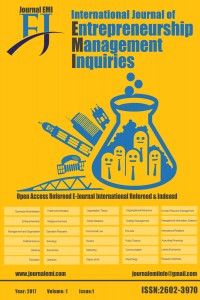Abstract
References
- Fawzi, N. (2009). Cyber-Mobbing: Ursachen und Auswirkungen von Mobbing im Internet 37. 1.
- Aufl.. Baden-Baden: Nomos, Ed. Fischer.Fellinger, H. cybermoobbing unD möGlIcHe präventIve lösunGsAnsätZe. Handbuch für Jugendarbeit, 79-84 (https://www.spektrum.at).
- Gabler, H. (2013). Cyber-Mobbing in sozialen Netzwerken. Philotec. 1-23.
- Goodwin, B., & Fawzi, N. (2012). Cyberbullying-related behaviour and third-person effect. eYouth. Balancing between opportunities and risks. Brussels: Peter Lang, 163-180.
- Grimm, P., & Clausen-Muradian, E. (2009). Cyber-Mobbing–psychische Gewalt via Internet:„Ja, Beleidigungen, Drohungen. So was halt.“(Alba). KJuG (54), (2), 33-37.
- Grimm, P., Rhein, S., & Clausen-Muradian, E. (2008). Gewalt im Web 2.0: Der Umgang Jugendlicher mit gewalthaltigen Inhalten und Cyber-Mobbing sowie die rechtliche Einordnung der Problematik, 1.
- Aufl., Vistas.Hinduja, S., & Patchin, J. W. (2008). Cyberbullying: An exploratory analysis of factors related to offending and victimization. Deviant behavior, 29(2), 129-156.
- Hogh, A., Henriksson, M. E., & Burr, H. (2005). A 5-year follow-up study of aggression at work and psychological health. International Journal of Behavioral Medicine, 12(4), 256-265.
- Kaschnitz, S. (2016). Cybermobbing. Virtuelle Welten–reale Gefahren. Pädiatrie & Pädalogie (3), 117-120.
- Katzer, C., & Fetchenhauer, D. (2007). Cyberbullying: aggression und sexuelle viktimisierung in chatrooms. Gewaltprävention bei kindern und jugendlichen, 1, 123-138.
- Katzer, C., Fetchenhauer, D., & Belschak, F. (2009). Cyberbullying: Who are the victims? A comparison of victimization in Internet chatrooms and victimization in school. Journal of Media Psychology, 21(1), 25-36.
- Leymann, H. (1996). The content and development of mobbing at work. European journal of work and organizational psychology, 5(2), 165-184.
- Marx, K. (2016). Denn sie wissen nicht, was sie da reden? Diskriminierung im Cybermobbing-Diskurs als Impuls für eine sprachkritische Diskussion. Institut für Deutsche Sprache, Bibliothek.Marx, K. (2016). Virtueller Rufmord-Offene Fragen aus linguistischer Perspektive. Institut für Deutsche Sprache, Bibliothek.
- Morgenstern, D. (2012). Cyber-Mobbing: insbesondere bei Jugendlichen an Schulen und Berufsschulen.
- Paine, T. (2009). Virtual violence: protecting children from cyberbullying. The Rights of Man, Vol.2, 1-61.
- Pfetsch, J., Steffgen, G., Gollwitzer, M., & Ittel, A. (2011). Prevention of aggression in schools through a bystander intervention training. International Journal of Developmental Science, 5(1-2), 139-149.
- Rayner, C. (1997). The incidence of workplace bullying. Journal of Community & Applied Social Psychology, 7(3), 199-208.
- Sitzer, P., Marth, J., Kocik, C., & Müller, K. N. (2012). Cyberbullying bei Schülerinnen und Schülern/Institut für interdisziplinäre Konflikt-und Gewaltforschung (IKG).
- Tetik, S. (2010). Mobbing kavramı: Birey ve örgütler açısından önemi. Karamanoğlu Mehmetbey Üniversitesi Sosyal ve Ekonomik Araştırmalar Dergisi, 2010(1), 81-89.
- Tınaz, P. (2006). Mobbing: İşyerinde Psikolojik Taciz. Çalışma ve Toplum, 3, 11-22.
Abstract
Son yıllarda
sanal alemde yaşanan hızlı teknolojik gelişmeler ve bu yönde yapılan inovatif
değişiklikler, toplumsal faydaları yanında görünmeyen bazı dezavantajlı
konuları da gündeme getirmektedir. Bunlardan biri de siber (sanal) mobbing ya
da siber taciz olarak adlandırabileceğimiz bir olgudur. Özünde bilgi iletişim
teknolojileri vasıtasıyla yapılan taciz, hakaret veya tehdit gibi
nitelendirebilceğimiz davranışları içeren bu saldırı, kurbanı fiziksel ve
ruhsal açıdan tükenmeye sürüklemekte ve sonuçta birçok bireysel performans
faktörüne negatif olarak etkide bulunmaktadır. Bu kapsamda henüz Türkçe
literatür açısından yeni olan bu kavramı daha geniş tanımlamak amacıyla
kavramsal olarak mevcut çalışma ile bu türden saldırıların kavramsal tanımları,
öncülleri ve sonuçlarına yönelik değerlendirmelerde bulunulmuştur.
Keywords
References
- Fawzi, N. (2009). Cyber-Mobbing: Ursachen und Auswirkungen von Mobbing im Internet 37. 1.
- Aufl.. Baden-Baden: Nomos, Ed. Fischer.Fellinger, H. cybermoobbing unD möGlIcHe präventIve lösunGsAnsätZe. Handbuch für Jugendarbeit, 79-84 (https://www.spektrum.at).
- Gabler, H. (2013). Cyber-Mobbing in sozialen Netzwerken. Philotec. 1-23.
- Goodwin, B., & Fawzi, N. (2012). Cyberbullying-related behaviour and third-person effect. eYouth. Balancing between opportunities and risks. Brussels: Peter Lang, 163-180.
- Grimm, P., & Clausen-Muradian, E. (2009). Cyber-Mobbing–psychische Gewalt via Internet:„Ja, Beleidigungen, Drohungen. So was halt.“(Alba). KJuG (54), (2), 33-37.
- Grimm, P., Rhein, S., & Clausen-Muradian, E. (2008). Gewalt im Web 2.0: Der Umgang Jugendlicher mit gewalthaltigen Inhalten und Cyber-Mobbing sowie die rechtliche Einordnung der Problematik, 1.
- Aufl., Vistas.Hinduja, S., & Patchin, J. W. (2008). Cyberbullying: An exploratory analysis of factors related to offending and victimization. Deviant behavior, 29(2), 129-156.
- Hogh, A., Henriksson, M. E., & Burr, H. (2005). A 5-year follow-up study of aggression at work and psychological health. International Journal of Behavioral Medicine, 12(4), 256-265.
- Kaschnitz, S. (2016). Cybermobbing. Virtuelle Welten–reale Gefahren. Pädiatrie & Pädalogie (3), 117-120.
- Katzer, C., & Fetchenhauer, D. (2007). Cyberbullying: aggression und sexuelle viktimisierung in chatrooms. Gewaltprävention bei kindern und jugendlichen, 1, 123-138.
- Katzer, C., Fetchenhauer, D., & Belschak, F. (2009). Cyberbullying: Who are the victims? A comparison of victimization in Internet chatrooms and victimization in school. Journal of Media Psychology, 21(1), 25-36.
- Leymann, H. (1996). The content and development of mobbing at work. European journal of work and organizational psychology, 5(2), 165-184.
- Marx, K. (2016). Denn sie wissen nicht, was sie da reden? Diskriminierung im Cybermobbing-Diskurs als Impuls für eine sprachkritische Diskussion. Institut für Deutsche Sprache, Bibliothek.Marx, K. (2016). Virtueller Rufmord-Offene Fragen aus linguistischer Perspektive. Institut für Deutsche Sprache, Bibliothek.
- Morgenstern, D. (2012). Cyber-Mobbing: insbesondere bei Jugendlichen an Schulen und Berufsschulen.
- Paine, T. (2009). Virtual violence: protecting children from cyberbullying. The Rights of Man, Vol.2, 1-61.
- Pfetsch, J., Steffgen, G., Gollwitzer, M., & Ittel, A. (2011). Prevention of aggression in schools through a bystander intervention training. International Journal of Developmental Science, 5(1-2), 139-149.
- Rayner, C. (1997). The incidence of workplace bullying. Journal of Community & Applied Social Psychology, 7(3), 199-208.
- Sitzer, P., Marth, J., Kocik, C., & Müller, K. N. (2012). Cyberbullying bei Schülerinnen und Schülern/Institut für interdisziplinäre Konflikt-und Gewaltforschung (IKG).
- Tetik, S. (2010). Mobbing kavramı: Birey ve örgütler açısından önemi. Karamanoğlu Mehmetbey Üniversitesi Sosyal ve Ekonomik Araştırmalar Dergisi, 2010(1), 81-89.
- Tınaz, P. (2006). Mobbing: İşyerinde Psikolojik Taciz. Çalışma ve Toplum, 3, 11-22.
Details
| Primary Language | English |
|---|---|
| Subjects | Economics |
| Journal Section | Articles |
| Authors | |
| Publication Date | August 20, 2018 |
| Submission Date | July 31, 2018 |
| Acceptance Date | August 15, 2018 |
| Published in Issue | Year 2018 Volume: 2 Issue: 2 |



Journal EMI e-mail Adresi: internationaljournalemi@gmail.com
JOURNAL EMI Creative Commons Attribution 4.0 Uluslararası Lisansı ile lisanslanmıştır.


